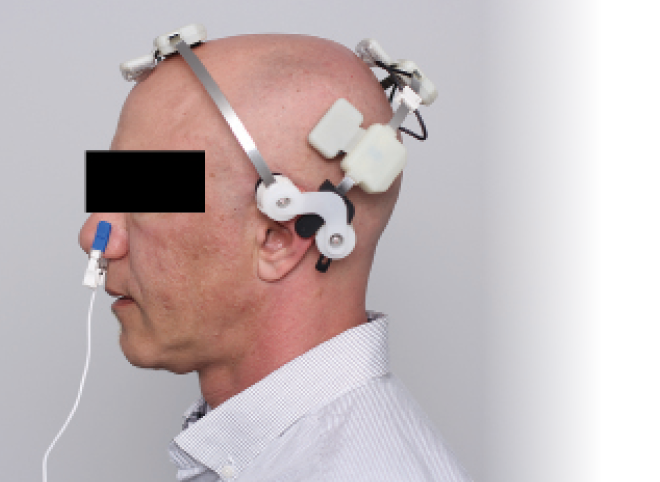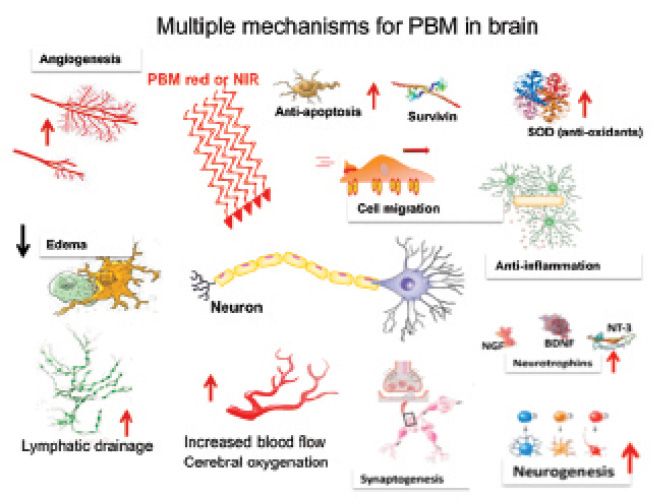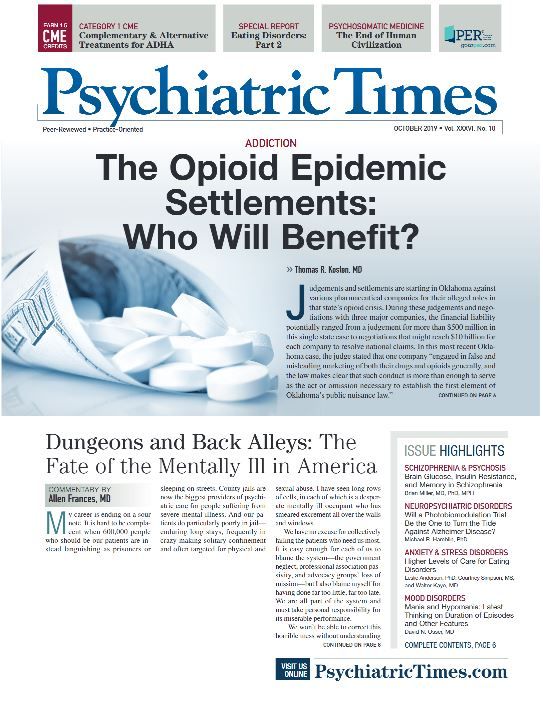Publication
Article
Psychiatric Times
Will the Photobiomodulation Trial Be the One to Turn the Tide Against Alzheimer Disease?
Author(s):
In light of recent failed trials, why would another trial by a small Canadian company be expected to succeed against the odds?

FIGURE 1.The Vielight Neuro RX Gamma in use

FIGURE 2. Multiple mechanisms for PBM in brain

Neuropsychiatric Disorders
On May 22, 2019, Vielight Inc, a Toronto company, announced that it was commencing the recruitment of participants for a pivotal trial using near infrared light as an intervention for Alzheimer disease (AD). Vielight’s proposed intervention is based on photobiomodulation (PBM) involving the delivery of low-power near infrared light from light emitting diodes (LEDs) to the brain (Figure 1). In light of recent failed trials, why would another trial by a small Canadian company be expected to succeed against the odds? The proposed justification is that PBM works by “helping the brain repair itself,” rather than by targeting a single biological mechanism.
Understanding failed trials
No new drug for treating AD has been approved since 2003, at which time memantine (a blocker of the N-methyl-D-aspartate receptor [NMDA] subfamily glutamate receptor) received FDA approval. There have been several reasons offered to explain the repeated failures of AD drug trials-ranging from targeting the wrong biological mechanisms, to suboptimal methodologies, to the late disease stage of the participants. There is a trend in new drug trials to target populations with preclinical and prodromal disease, and increasingly towards non β-amyloid (Aβ) mechanisms of action in the earlier phases of drug development. There has been negli gible discussion on any physical treatment modality, which appears to have been eclipsed by a continued search for prospective drugs despite multiple repeated failures.
Broadly speaking, drug development takes the approach of molecular screening, which may or may not be based on alteration of phenotypes. Over the years, many of these single molecule candidates have been related to Aβ oligomers and/or plaques or tau misfolding. AD has been found to have a much more complex etiology, with multiple risk factors that argue against single molecule targeting. On the other hand, PBM is an intervention that is able to modify multiple pathways, which may be an elegant answer to a complex problem.
The multifactorial and complex risk factors related to AD
Between 60% and 80% of the risk of AD is genetic, and many genes seem to be involved. Other risk factors include a history of head injury, depression, and hypertension. AD is generally characterized by diffuse atrophy of the entire brain, accompanied by extracellular Aβ plaques and intraneuronal neurofibrillary tangles composed of hyperphosphorylated tau protein. AD mechanisms have been widely discussed, but there is still a lack of fundamental understanding with much ongoing debate.
Neuroinflammation and reactive gliosis are also hallmarks of AD. Accumulating evidence suggests that that microglia with the M1 phenotype are contributors to inflammation in AD.1 However, the M2 microglial phenotype is non-inflammatory and is also proposed to be able to clear the amyloid plaques by phagocytosis. PBM is capable of switching the microglial phenotype from M1 to M2, which partly explains its well-known anti-inflammatory effects.
Reductions in mitochondrial activity and glucose metabolism are widely seen in AD, including changes in cytochrome c oxidase and morphological changes in mitochondria. PBM is consistently cited to be able to improve mitochondrial activity.2
Recent theories have implicated changes in the gut microbiome. The bacteria may secrete bacterial amyloid that may trigger cross-seeding of amyloid plaques, or else the bacteria may overstimulate the innate immune response. Bacteria such as Porphyromonas gingivalis have been found in AD brains.3 Aβ peptide may be an endogenous response for antimicrobial defense. Emerging evidence suggests that PBM can improve the gut microbiome.4
Mechanisms of photobio-modulation in the brain
A bewildering array of different mechanisms and pathways have been proposed to account for the benefits of transcranial PBM on the brain. These are schematically shown in Figure 2.
Metabolism. Improved metabolic function of the mitochondria is one of the most easily recognized effects of PBM, and increased intracellular adenosine triphosphate production (required for cellular energy) is one of the most strongly supported mechanisms of action. Several preclinical studies have shown that the brain adenosine triphosphate content was increased in experimental animals subjected to transcranial PBM.
Blood flow. Disorders of cerebral blood flow have been associated with AD. Researchers have found that transcranial PBM induced significantly increased cytochrome c oxidase concentration and led to a higher oxygenated hemoglobin concentration in the treated site.5
It has been suggested that the release of nitric oxide as result of PBM is responsible for the increased cerebral blood flow.6 Nitric oxide is a major neuronal signaling molecule that, among other functions, possesses the ability to trigger vasodilation.
Reduction and Neuroprotection in oxidative stress. Findings suggest that PBM can be utilized for neuroprotection-essentially, to protect cells from damage, to promote their survival and longevity, and reverse apoptotic signaling processes.7 PBM may also protect cells from the harmful effects of toxins, which can be traced to its stimulation of cytochrome c oxidase.8 PBM lowers excitotoxicity effects, thus promoting cell survival and lowering oxidative stress.9
Anti-inflammatory effects. Many diseases, including AD, can be traced (at least in part) to chronic inflammation. One way that PBM helps to quell inflammation is through the inhibition of the cyclo-oxygenase 2 (COX-2) enzyme. 635 nm light irradiation at low power was able to cause COX-2 inhibition by decreasing intracellular ROS.10 PBM can also modulate cellular levels of free nuclear factor kappa-light-chain-enhancer of activated B cells (NFkB), which contributes to inflammation.11
Neurogenesis. Recent research showed that there was a sharp drop in hippocampal neurogenesis in people with AD, and this reduction further increased along with disease progression.12 The first report of neurogenesis being stimulated by transcranial PBM delivered to the brain came from a study in 2006 that treated stroke in rats.13 The number of newly formed neuronal cells as well as migrating cells was significantly elevated in the subventricular zone (SVZ). A similar result was reported by other investigators who treated mice that had suffered TBI using transcranial PBM.14 They found that there was a significant increase in neuroprogenitor cells in the dentate gyrus of the hippocampus and in the SVZ.
Synaptogenesis. One manner in which transcranial PBM may promote synaptogenesis could be by up-regulation of brain derived neurotrophic factor (BDNF). BDNF is also a mediator of the protein synapsin-1, which improves synaptogenesis by accelerating the development of neuronal fibers and maintaining synaptic contacts. PBM has been shown to up-regulate the expression of BDNF, thus positively affecting dendritic morphogenesis and improved neuronal connectivity.15
Gamma rhythms. Iaccarino and colleagues26 reported that 40 Hz pulsed blue light could reduce the load of Aβ 1-40 and Aβ 1-42 peptides and lessen the amyloid plaque burden in the visual cortex of the brain in a mouse model of AD. The hypothesis was that the microglia in the brain were transformed to an engulfing state by the gamma entrainment. A subsequent study from the same group showed that 40 Hz pulsed light was neuroprotective and improved cognitive performance in mice that include a tau mouse model of neurodegeneration. They found improved synaptic function, enhanced neuroprotective factors, and reduced DNA damage in neurons, while the inflammatory response in microglia was reduced.
Saltmarche and colleagues16 treated five patients who had a diagnosis of mild to moderately severe dementia. The study used the Vielight Alpha (near infrared at 810 nm, pulsed at 10Hz) that combines transcranial plus intranasal PBM to treat the cortical nodes of the default mode network. There were 12 weeks of active treatment consisting of weekly in-office transcranial/intranasal, and daily home-based intranasal, plus a 4-week no-treatment follow up.
The participants were assessed with the Alzheimer Disease Assessment Scale-cognitive (ADAS-cog) and the Mini-Mental State Examination (MMSE) scales. At 12 weeks, cognitive function was significantly improved (MMSE increased by a mean of 2.6, P < .003; ADAS-cog decreased by a mean of 7.4, P < .023). Moreover, sleep was improved, there were fewer angry outbursts, less anxiety, and wandering. There were no negative adverse effects. Precipitous declines were observed during the 4-week follow-up/no-treatment period. It should be noted that this small trial commenced as a placebo-controlled trial, but the patients randomized to receive placebo dropped out before the conclusion.
A second pilot trial tested the effects of home PBM on cognitive and behavioral function, cerebral perfusion, and resting-state functional connectivity in eight patients with dementia.17 The PBM treatments were administered at home three times per week with the Vielight Neuro Gamma device (pulsed at 40 Hz). The participants were assessed with the ADAS-cog and the Neuropsychiatric Inventory at baseline and at 6 and 12 weeks, and with arterial spin-labeled perfusion MRI and resting-state functional MRI at baseline and 12 weeks.
After 12 weeks, there were improvements on ADAS-cog (P = .007) and Neuropsychiatric Inventory (P = .03), increased cerebral perfusion (P < .03), and increased connectivity between the posterior cingulate cortex and lateral parietal nodes within the default-mode network in the transcranial PBM group. The lack of blinding was a limitation of this study.
Conclusion
PBM can trigger cellular activities that restore cellular metabolism, promote blood flow, neuroprotection, and reduce levels of inflammation and oxidative stress. All of these cellular mechanisms can be summed up as “helping the brain to repair itself.” While PBM will probably not be a permanent cure for AD, if it can be proven to be effective in large well-controlled trials, it could make a substantial impact on patients with AD and their caregivers.
If demonstrated to be effective, and with no reports of significant adverse events having been made as yet, the significance for geriatric psychiatrists is great. The potential of a modality that could turn the tide on AD with a convenient, affordable, home-use device would make a big impact. The preliminary clinical evidence from these small studies to date is impressive when compared to the results of controlled studies using AD drugs. The findings support moving forward with larger, double-blind, placebo-controlled trials using the Neuro PX Gamma (810 nm near infrared at 40 Hz).
The pivotal trial involves 228 participants with moderate to severe cognitive impairment, in a double-blind study at eight sites across North America. The trial incorporates 24 weeks of assessment with the Severe Impairment Battery (SIB) as its primary endpoint. It is expected to take three years to complete. The details of this study have been reviewed by the FDA; these details are published online at ClinicalTrials.gov.18
Disclosures:
Dr Hamblin is Principal Investigator, Wellman Center for Photomedicine, Massachusetts General Hospital, Associate Professor, Department of Dermatology, Harvard Medical School, Boston, and Affiliated Faculty, Harvard-MIT Division of Health Sciences and Technology, Cambridge, MA. He reports that he receives financial compensation as a Scientific Advisory Board Member and Consultant to Vielight Inc. For the sake of completeness other potential conflicts of interest are Scientific Advisory Boards: Transdermal Cap Inc, Cleveland, OH; BeWell Global Inc, Wan Chai, Hong Kong; Hologenix Inc. Santa Monica, CA; LumiThera Inc, Poulsbo, WA; Vielight, Toronto, Canada; Bright Photomedicine, Sao Paulo, Brazil; Quantum Dynamics LLC, Cambridge, MA; Global Photon Inc, Bee Cave, TX; Medical Coherence, Boston MA; NeuroThera, Newark DE; JOOVV Inc, Minneapolis-St. Paul MN; AIRx Medical, Pleasanton CA; FIR Industries, Inc. Ramsey, NJ; UVLRx Therapeutics, Oldsmar, FL; Ultralux UV Inc, Lansing MI; Illumiheal & Petthera, Shoreline, WA; MB Lasertherapy, Houston, TX; ARRC LED, San Clemente, CA; Varuna Biomedical Corp. Incline Village, NV; Niraxx Light Therapeutics, Inc, Boston, MA. Consulting; Lexington Int, Boca Raton, FL; USHIO Corp, Japan; Merck KGaA, Darmstadt, Germany; Philips Electronics Nederland B.V. Eindhoven, Netherlands; Johnson & Johnson Inc, Philadelphia, PA; Sanofi-Aventis Deutschland GmbH, Frankfurt am Main, Germany. Stockholdings: Global Photon Inc, Bee Cave, TX; Mitonix, Newark, DE.
References:
1. Tang Y, Le W. Differential roles of M1 and M2 microglia in neurodegenerative diseases. Mol Neurobiol. 2016;53:1181-1194.
2. Weidling I, Swerdlow RH. Mitochondrial dysfunction and stress responses in Alzheimer disease. Biology (Basel). 2019;8:E39.
3. Dominy SS, Lynch C, Ermini F, et al. Porphyromonas gingivalis in Alzheimer disease brains: Evidence for disease causation and treatment with small-molecule inhibitors. Sci Adv. 2019;5:eaau3333.
4. Liebert A. Emerging applications of photobiomodulation therapy: the interaction between metabolomics and the microbiome. Photomed Laser Surg. 2018;36:515-517.
5. Wang X, Tian F, Soni SS, et al. Interplay between up-regulation of cytochrome-c-oxidase and hemoglobin oxygenation induced by near-infrared laser. Sci Rep. 2016;6:30540.
6. Naeser MA, Martin PI, Ho MD, et al. Transcranial, red/near-infrared light-emitting diode therapy to improve cognition in chronic traumatic brain injury. Photomed Laser Surg. 2016;34:610-626.
7. Ganeshan V, Skladnev NV, Kim JY, et al. Pre-conditioning with Remote Photobiomodulation modulates the brain transcriptome and protects against MPTP insult in mice. Neurosci. 2019;400:85-97.
8. Eells JT, Gopalakrishnan S, Valter K. Near-infrared photobiomodulation in retinal injury and disease. Adv Exp Med Biol. 2016;854:437-441.
9. Huang YY, Nagata K, Tedford CE, Hamblin MR. Low-level laser therapy (810 nm) protects primary cortical neurons against excitotoxicity in vitro. J Biophotonics. 2014;7:656-664.
10. Lim W, Kim J, Kim S, et al. Modulation of lipopolysaccharide-induced NF-kappaB signaling pathway by 635 nm irradiation via heat shock protein 27 in human gingival fibroblast cells. Photochem Photobiol. 2013;89:199-207.
11. Yamaura M, Yao M, Yaroslavsky I, et al. Low level light effects on inflammatory cytokine production by rheumatoid arthritis synoviocytes. Lasers Surg Med. 2009;41:282-290.
12. Hollands C, Bartolotti N, Lazarov O. Alzheimer disease and hippocampal adult neurogenesis; exploring shared mechanisms. Front Neurosci. 2016;10:178.
13. Oron A, Oron U, Chen J, et al. Low-level laser therapy applied transcranially to rats after induction of stroke significantly reduces long-term neurological deficits. Stroke. 2006;37:2620-2624.
14. Xuan W, Vatansever F, Huang L, Hamblin MR. Transcranial low-level laser therapy enhances learning, memory, and neuroprogenitor cells after traumatic brain injury in mice. J Biomed Opt. 2014;19:108003.
15. Xuan W, Agrawal T, Huang L, et al. Low-level laser therapy for traumatic brain injury in mice increases brain derived neurotrophic factor (BDNF) and synaptogenesis. J Biophotonics. 2015;8:502-511.
16. Saltmarche AE, Naeser MA, Ho KF, et al. Significant improvement in cognition in mild to moderately severe dementia cases treated with transcranial plus intranasal photobiomodulation: case series report. Photomed Laser Surg. 2017;35:432-441.
17. Chao LL. Effects of home photobiomodulation treatments on cognitive and behavioral function, cerebral perfusion, and resting-state functional connectivity in patients with dementia: a pilot trial. Photobiomodul Photomed Laser Surg. 2019;37:133-141.
18. Clinical Trials.Gov. Neuro RX Gamma: pivotal phase. https://clinicaltrials.gov/ct2/show/NCT03484143. Accessed September 8, 2019.







